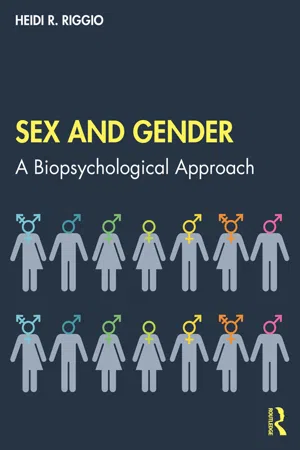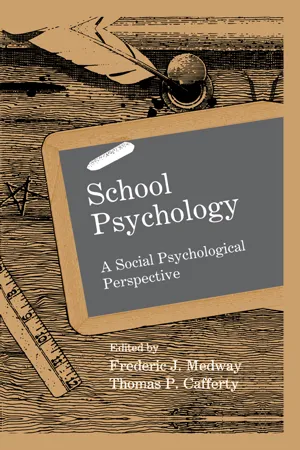Psychology
Social Learning Theory Gender
Social Learning Theory Gender refers to the concept that gender roles and behaviors are learned through observation, imitation, and reinforcement within a social context. This theory suggests that individuals acquire their understanding of gender through interactions with others, such as parents, peers, and media. It emphasizes the role of socialization in shaping gender identity and behavior.
Written by Perlego with AI-assistance
Related key terms
12 Key excerpts on "Social Learning Theory Gender"
- Steven Burton, James Reid, Steven Burton, James Reid(Authors)
- 2017(Publication Date)
- Routledge(Publisher)
Biology and experience, then, both play a part. What we can probably say with some certainty is that whereas biological characteristics are difficult, though not impossible, to change, our experiences will determine how we build on our biology to become who we are. Children see how other people behave, they process and remember this behaviour, and then imitate it in what they think are the appropriate circumstances. The response of other people (praising, rewarding, correcting, admonishing or whatever) will then play a big part in whether or not that behaviour is repeated. Because adults tend to have fairly constant views on gender-appropriate behaviour and gender roles, behaviour that conforms to these views is more likely to be reinforced than conflicting behaviour, so the process of socialisation, of learning to behave in a way acceptable to others, continues.Social learning theory and social cognitive theory are not limited to understanding gender identity, but may help us to understand other aspects of how children grow and develop. These theories also remind us of the importance of modelling appropriate behaviour in the early years setting; children will develop the sophisticated filtering system that helps them to discriminate between behaviours that they should imitate and behaviours that they should abandon, but this process takes time. While this development is taking place, imitation may be rather more indiscriminate, and careless practitioners can easily find themselves the subject of inappropriate imitation!- eBook - ePub
- Judith E. Owen Blakemore, Sheri A. Berenbaum, Lynn S. Liben(Authors)
- 2013(Publication Date)
- Psychology Press(Publisher)
2001 ). Children are exposed to many models, and not all behave alike. As some models, either figures in the media or in children’s own lives, change their gender role behaviors, children can see these new norms, and choose which behaviors to imitate. It is also the case that some people (e.g., some parents) may reward traditional gender roles, whereas others may reward nontraditional roles, and different children may be exposed to more or less traditional influences.The Transition to Social Cognitive Theory
As social learning theory evolved, Bandura came to emphasize more cognitive factors in addition to basic learning mechanisms (Bandura, 1986 , 1992 , 1999 , 2001 ), and the theory has become known as social cognitive theory. Because of its emphasis on cognition, we will save our discussion of social cognitive theory for the next chapter.Evaluation of Social Learning Theory
Social learning theory grew out of scientific research on behavior and has certainly served as a guide to research in many areas of psychology, including children’s gender development. The changes from learning theory to social learning theory to social cognitive theory also reflect the kinds of changes that epitomize a scientific approach: the theory is supposed to change when research findings cannot be accounted for by the current version of the theory. The major question of evaluation then, is to what extent research confirms or contradicts the theory’s predictions. Is there evidence that reinforcement, punishment, observational learning, and direct teaching influence children’s gender development? Because we have not yet discussed the research on parents’ and teachers’ treatment of children, the modeling of gender norms in books, television and other media, nor have we looked at children’s peer groups, this question is difficult to answer convincingly at this point. We will see later that there is certainly evidence in support of a learning approach, but also some in contradiction. - eBook - ePub
Growing Points in Developmental Science
An Introduction
- Willard W. Hartup, Rainer K. Silbereisen(Authors)
- 2005(Publication Date)
- Psychology Press(Publisher)
In social learning theory, children were still seen as being shaped by direct positive and negative reinforcement. But it was also shown that children could learn vicariously from seeing how other children’s gender-appropriate or gender inappropriate behaviour were reacted to by others (Bandura, 1965). Apart from learning about the consequences of such behaviour, children could also learn by observation what behaviours were characteristic of each sex. And of course, they could learn these things not only from what they observed within their families, schools, and neighbourhoods, but from films or TV, or as depicted in stories (Mischel, 1966). The introduction of observational learning gave great added power to learning theory. But it also brought some complications. In daily life, boys and girls are exposed to models of both sexes. Both boys and girls presumably would learn the same facts concerning what behaviour is appropriate for boys, what for girls. The theory called for selective imitation, such that boys would adopt behaviour depicted by male models, or adapt their own behaviour according to the reinforcement patterns they saw being provided for male, rather than female, children. At the least, this required that children would know their own gender and that of the people whom they observed. Then too, it required that children should be able to summarise and generalise from multiple exemplars, and deal with exceptions. In addition, it called for some motivation to adopt the behaviour patterns of people who are “the same as me” with respect to gender. Clearly, the theory called for the extensive incorporation of cognitive elements in gender development. THE COGNITIVE PERSPECTIVE In the 1970s and 1980s, there was a strong surge of interest in gender cognitions - eBook - ePub
Psychology and Gender
An Advanced Reader
- Sadhana Avinash Natu(Author)
- 2023(Publication Date)
- Routledge India(Publisher)
Mischel (1966) focused on the rewards and punishments that children receive for sex-appropriate and sex-inappropriate behaviours. He also highlighted the vicarious learning that observation and modelling can provide. His theory located the source of gender role typing in the gender-differentiated practices of the socializing community. It means that when a boy displays ‘courage’, which is thought to be a masculine attribute culturally, he is praised, and if he does not, he is ridiculed or, worse still, called a ‘sissy’. This reinforcement can happen at home, in school, or among peers and sometimes in all three locations. Hence, social learning takes place through the process of ‘identification’ (generally with the same-sex parent, teachers, peers, role models) and later ‘imitation’ (think of girls dressing up like their mothers, trans persons cross-dressing, boys imitating the swagger of their favourite hero or sportsman, and so on) and ‘internalization’ (we end up unconsciously copying the gestures, facial expressions, and vocabulary of our role models in the private and public spheres).This theory has received both acceptance and criticism – acceptance due to its generality, since the theory posits that there is nothing special about gender. Hence, feminists argue that if there is nothing special about gender, then the phenomenon of gender role typing is neither inevitable nor unalterable. At the same time, this theory is criticized because it depicts the child as a passive recipient and observer of culturally transmitted information. In fact, research has revealed that be it rules of gender or rules of syntax, the child is not a passive recipient; she or he is actively constructing rules to organize and thereby to comprehend the vast array of information in his or her world (Bem, 1993 ).While applying the social learning theory to gender differences in aggression and sexuality, we understand how useful it is. For example, in a household where aggression and violence are normalized, a boy is likely to internalize such behaviour and not question it, whereas a girl is likely to observe the passive–aggressive behaviour of the women in the family and imitate it. While picking up the dos and don’ts of expression of sexuality too, children are likely to observe, imitate, and model their behaviour on family members, peers, relatives, and depictions on media and social media. Hence, with respect to understanding gender differences in both socialization practices and cultural double standards and perpetuating gender role stereotypes, this theory gives us a lot of insight. It also assures us that ‘what is learnt can be unlearnt’. This principle is used in anger management, questioning of domestic violence, and instigation of both behavioural change (individual) and social change. - eBook - ePub
- John Coleman(Author)
- 2012(Publication Date)
- Routledge(Publisher)
They argue that, in order to maintain male dominance in our societies, it becomes necessary for the male to overcome his awe and envy of female womb and breasts as well as the power of mother over infant; thus, he rejects his attachment to mother and relates to father. In contrast, the female has difficulty establishing her same-sex identification for two reasons: the ‘myth’ of the all-powerful ‘mother image’ generates an expectation of a demanding role to incorporate as one’s own, and the status and privilege provided exclusively to males are envied and desired. It should be noted that neither theory of identification has undergone rigorous research investigation to support its position. Both perspectives focused on explaining why identifications would take place and are good examples of the impact of the societal context on theory development. Social learning theory By contrast, the social learning theory has undergone extensive empirical investigation that has resulted in an increase in our awareness of the complexity of processes that impact on the development and maintenance of one’s gender role throughout the life span. Initially proposed by Bandura and Walters (1963) and Mischel (1970), the basic mechanisms of this behaviourally-oriented model include reinforcement, observation of models, and imitation. In infancy and throughout the pre-school years, the basic principles of reinforcement are already at work. Significant others – such as parents, media heroes, and peers – provide positive reinforcement for engaging in behaviour deemed appropriate for one’s sex. Positive consequences following one’s behaviour increase the likelihood that the particular behaviour will be repeated. Positive reinforcements include such things as praise, smiles, physical contact, desired foods and toys. For example, females tend to be exposed to doll-like toys with faces more extensively than are boys - No longer available |Learn more
Gender
Psychological Perspectives, Seventh Edition
- Linda Brannon(Author)
- 2016(Publication Date)
- Routledge(Publisher)
Social learning theory emphasizes the influence of the social environment, including the media. Biological sex differences furnish the basis for gender identity, but social learning theorists contend that a great many other characteristics and behaviors that have no relation to sex have been tied to gender, such as the colors pink and blue. In this view, gender identity development is determined by social factors (Bandura, 1986; Bandura & Bussey, 2004; Bussey & Bandura, 1999).Table 5.5 Results of Reinforcement and Punishment for Gender-Related BehaviorsBehavior Consequences Result Little girl plays with tea set Reinforcement: Her mother praises her toy choice Girl plays with tea set again Little girl plays with truck Punishment: Her mother scolds her for choosing a truck Girl does not play with truck again Little boy plays with tea set Punishment: His mother scolds him for choosing a tea set Boy does not play with tea set again Little boy plays with truck Reinforcement: His mother praises his toy choice Boy plays with truck again The social learning approach is a variation of traditional learning theory, which includes the principles of operant conditioning developed by B. F. Skinner. Operant conditioning is a form of learning based on applying reinforcement and punishment . A reinforcer is any stimulus that increases the probability that a behavior will recur. A behavior is more likely to be repeated in the future if that person (or animal) has received a reinforcer after performing the behavior in the past. On the other hand, a person is less likely to repeat a behavior in the future if that person has been punished after performing the behavior. Punishment is any stimulus that decreases the probability that a behavior will recur. The reinforcements and punishments in each individual’s history contribute to present and future behavior. Thus, future behavior can be predicted from past experience. Table 5.5 - eBook - ePub
Sex and Gender
A Biopsychological Approach
- Heidi R. Riggio(Author)
- 2020(Publication Date)
- Routledge(Publisher)
Theories of gender may address individual gender identity development, adoption of gender roles, and development of social and cultural ideology about gender. Good theories are comprehensive, testable, and falsifiable, integrate findings from multiple domains, and serve as a guide to researchers. Biological explanations focus on genetic and physiological processes in development of gender identity, and links between hormones and gendered behaviors, including nurturance and aggression. Social learning and social cognitive approaches emphasize the learning of gender roles and identity through observation and modeling of others’ behaviors, especially important models of feminine and masculine behavior like parents. Cognitive development theories focus on gender identity as a developmental milestone and achievement of gender constancy, the recognition that one’s gender is stable and immutable. Gender schema theory emphasizes development of mental knowledge structures (schemas) representing gender categories and roles and the use of those structures in processing social information. Social role theory is a biosocial approach that links differences in reproductive roles and other physical differences between women and men to societal division of labor. Because women and men typically occupy certain roles, they come to be seen as possessing the characteristics necessary for role accomplishment, even when they do not occupy those specific roles. Parental investment is an evolutionary approach that predicts gender differences in aggressive and sexual behavior based on sex differences in reproduction and differential investment in each individual offspring. Social dominance theory asserts that societies exist in hierarchies, with people at the top of the hierarchy enjoying a disproportionate share of societal resources and benefits, while people at the bottom suffer a disproportionate share of societal shortcomings and liabilities. Finally, feminist approaches are psychoanalytic and focus on how mothers and their powerful presence in infancy affect gender identity development of girls and boys. Sometimes, men may experience gender role strain because of inconsistent and contradictory demands placed on men. Precarious manhood occurs when masculine identity is fragile and easily threatened, resulting in men’s compensatory demonstrations of masculine-typed behavior, including aggression. - eBook - ePub
Psychology and the Study of Education
Critical Perspectives on Developing Theories
- Cathal Ó Siochrú, Cathal Ó Siochrú(Authors)
- 2018(Publication Date)
- Routledge(Publisher)
Chapter 9 , and so in this chapter will focus on using learning theories to explain the development of gender identities.Consider this: What is the first question we ask when we hear someone has had a baby? For most of us the first question is some variation on ‘Is it a boy or girl?’ For the parents it may have started even earlier, with many parents wishing to know the gender of their child before it’s even born. Why do they need to know this in advance? Because there are preparations to make which depend on the gender; rooms and clothes need to be the right colour, for example. From birth, children are bombarded with gender related messages and lessons. In their games and stories males are presented in roles such as cowboys, knights, soldiers and leaders; females occupy roles such as mothers, nurses, cooks and princesses. Children receive approval (i.e. a reward) from their parents, teachers and friends in reaction to their gender appropriate behaviour and disapproval in reaction to gender inappropriate behaviour (Fauls and Smith, 1956). Not all of this is intentional indoctrination. Gelman et al. (2004) found that even those parents who were very egalitarian in their views on gender ended up endorsing implicit gender stereotypes when reading a story and did not correct the children when they made stereotypical comments about gender. All in all, learning theorists would say that the end product of all this association and reinforcement is long-term conditioning toward gender-appropriate behaviour.Research focus: parental support for study and career plans in STEMThe American National Center for Science and Engineering Statistics (2013) reported that the number of women in engineering and computing careers in the United States had remained below 30 per cent for the previous 20 years. One reason offered to explain this under-representation of women in STEM is that female students receive less encouragement in STEM subjects (Calabrese Barton et al. , 2013). According to Crisp et al. - eBook - ePub
The Handbook of Life-Span Development, Volume 2
Social and Emotional Development
- (Author)
- 2010(Publication Date)
- Wiley(Publisher)
Cognitive developmental theorists explain the motivation for observational learning in children, and social cognitive theories posit that cognitive processes play an important role in the acquisition of sex-typed behavior (Bussey & Bandura, 1984). Cognitive developmental theorists propose that children’s gradual acquisition of the gender concept, from initial identity as male or female through to an understanding that this identity will not change with time or with changes in appearance or activities, underpins the adoption of gender-appropriate behaviors (Kohlberg, 1966; Ruble & Martin, 1998). Cognitive theorists also posit that children are active agents in their own gender development, and that gender schemas, or systems of knowledge related to gender (similar to stereotypes), are involved in the acquisition of sex-typical behavior (Martin, Ruble, & Szkrybalo, 2002).Children are more likely to model the behavior of people of the same sex than the other sex, and this is particularly true for boys. After seeing videotapes of men and women consistently choosing one or the other of a pair of neutral items (e.g., an apple vs. a banana), children subsequently express more interest in the items that they have seen people of their own than the other sex choose, and the impact of the models is greater for boys than for girls (Perry & Bussey, 1979). Gender labels, which also tell children what items or activities are for their own versus the other sex, also influence children’s choices. If told, for instance, that brown xylophones are for boys and yellow xylophones are for girls (or vice versa), children tend to prefer the xylophone of the color they were told is for their sex (Masters et al., 1979). Television and other media are another source of information about gender-related behaviors, and the portrayal of males and females on television is highly sex stereotypical (Ruble, Martin, & Berenbaum, 2006). Television viewing also relates positively to sex stereotypic beliefs (Huston et al., 1992; Morgan & Shanahan, 1997). Although it is not possible to separate cause and effect in these studies of television and sex stereotypes (e.g., watching television may increase sex-stereotypic beliefs or people with stronger stereotypes to begin with may watch more television), the findings are consistent with predictions based on laboratory studies of the effects of modeling and labeling, lending some credence to the first interpretation. - eBook - ePub
Sex Differences in Cognitive Abilities
4th Edition
- Diane F. Halpern(Author)
- 2013(Publication Date)
- Psychology Press(Publisher)
There are also obvious differences among adults who model grown-up behaviors. Women may wear high heeled shoes, panty hose, make-up, nail polish, and dresses, while any man who wears these items is considered deviant. Men may wear wing-tipped shoes and men’s style clothing. Anyone who doubts that there are strong sanctions about something as simple as clothingtype should try to shop for shoes in the shoe department reserved for the other sex. The message that some shoe styles are appropriate only for women or men was probably never stated explicitly, but it was made clear just by observing. If you are a woman, you did not have to try to purchase shoes in the men’s shoe department, or if you are a man, you did not have to try to purchase shoes in the women’s shoe department to learn what is appropriate for your sex.Observational Learning
Same-sex modeling can promote same-sex differentiated patterns of behavior. —Kay Bussey and Albert Bandura (1984, p. 1292)According to social learning theory, children learn about sex role behaviors by observing between-sex differences as they are played out in the lives of the other children and adults with whom they interact and in the media. They then imitate the behaviors and attitudes of same-sex models. Social modeling theory differs from learning theory in that it does not assume that rewards and punishments must be received in order to shape behavior or that the child personally engages in the behavior. Sex role learning can occur from observing others and imitating them. Appropriate imitation is likely to be rewarded, as in the case of a young girl who dresses up in her mother’s shoes and old dresses. Inappropriate imitation is likely to be punished, as in the case of a young boy who dresses up in his mother’s shoes and old dresses. Thus, through a combination of observational learning, appropriate modeling, and rewards and punishments received both by the role models and the children in their attempts to imitate the models, boys and girls learn society’s sex roles.An interesting implication of social learning theory is that much of the learning is done by watching others, which means that sex role messages can come from a variety of sources outside of the home. Even if parents did not differentially socialize their children based on each child’s sex, there are still many opportunities for children to learn about sex-typed behaviors including those presented on television, in school classrooms, on the playground, and in the homes of others. These messages can even be learned from Barbie dolls and GI Joes and the various characters found in video games, books, and other media. With messages about appropriate female and male behavior coming from so many different sources, these messages would be almost impossible to ignore. - eBook - ePub
- Richard A. Lippa(Author)
- 2005(Publication Date)
- Routledge(Publisher)
Consistent with this view, a number of studies have found that heavy TV viewing in children is associated with stronger gender stereotypes (Eisenstock, 1984; McGhee & Frueh, 1980; Zuckerman, Singer, & Singer, 1980). Longitudinal studies have suggested that extended TV viewing fosters gender stereotypes, particularly in children who did not hold strong stereotypes to start with (Morgan, 1982). In a study that comes closest to demonstrating a cause-effect relationship between TV viewing and gender stereotypes, researchers studied a Canadian town that had not received TV transmissions because of its location in the Rocky Mountains; this town was nicknamed "Notel" by the researchers. When cable TV was introduced to Notel in the 1970s, children who lived there were studied and compared with children in two comparable Canadian towns that already received TV transmissions (Kimball, 1986). Researchers found that before TV transmissions started, the children of Notel had weaker gender stereotypes than the children from the comparison cities. However, after a couple of years of exposure to TV, the gender stereotypes displayed by Notel children grew significantly stronger, particularly among boys.Self-Socialization of Gender
The basic contention of social learning theories is that rewards, punishments, and role models influence children's gender-related behaviors and attitudes, Parents, teachers, schools, and societies treat girls and boys differently; as a result, children learn to do gender. However, the social learning of gender is only part of the story. Children also actively construct mental categories of male and female, and they apply these categories to themselves and to others.Researchers have posed some fundamental questions about the self-socialization of gender. Do children progress through definite stages of gender knowledge? Are children's gender-related self-concepts and gender knowledge related to their behavior as boys and girls? How does the social environment influence children's gender knowledge?Gender Knowledge
Haryard psychologist Lawrence Romberg (1966) was the first to argue that children's self-labeling was critical in gender development. According to Kohlberg, once children label themselves as boys or girls, they start to act consistently with their gender labels (see Chapter 3 ). How exactly do children come to understand the concepts of male and female - eBook - ePub
School Psychology
A Social Psychological Perspective
- Frederic J. Medway, Thomas P. Cafferty, Frederic Medway, Frederic J. Medway, Thomas P. Cafferty, Frederic Medway(Authors)
- 2013(Publication Date)
- Routledge(Publisher)
Paradoxically, this preference for affiliation with same-sex peers could provide opportunity for expanding the behaviors of children beyond sex-stereotyped boundaries. As they assume a variety of roles in their same-sex groups, they come to acquire more flexible behavioral expectations for themselves and members of their group (e.g., girls experiencing leadership and boys practicing providing support). These outcomes mirror goals articulated by proponents of single-sex education (e.g., Howe, 1984).Katz (1987) suggested the flexibility or rigidity of stereotyping to which children are exposed prior to acquiring gender constancy is seen again as they move into adolescence. Once gender identity is clearly established, less stereotyped attitudes tend to develop. Children become more likely to say that both men and women can do a wide variety of behaviors traditionally assigned to one sex or the other (Signorella & Liben, 1985). These findings suggest that complete attainment of gender constancy leads to more rather than less flexibility in gender-linked expectations. Perhaps having identity well in hand reduces the threat of entertaining notions of gender-role flexibility (Urberg, 1982).Given the press of social tradition described in this chapter, evidence that cognitive development might allow students within the school culture to develop gender-related cognitions beyond those modeled in that setting gives reason for optimism. At the same time, the fact of such limiting environments should be of concern to school psychologists who are well aware of the many children who do not develop cognitive capacity (or accrue reinforcement history, or gain ego strength) sufficient to override these forces. The role of education in providing opportunities for such development must be of great interest in our profession.Psychology in the SchoolsIn the midst of all these blatant and subtle sociocultural influences, we offer our services as school psychologists. To what extent do we perpetuate oppressive stereotypes? How do we respond differently to the girls and boys, the women and men with whom we work? These are questions for personal introspection as well as professional concern. Recent research in the area of women’s psychology has given us insight into the psychological experiences of women and girls.
Index pages curate the most relevant extracts from our library of academic textbooks. They’ve been created using an in-house natural language model (NLM), each adding context and meaning to key research topics.











